How robots are eating the last of America’s—and the world’s—traditional manufacturing jobs
Baxter, the affordable, humanoid industrial robot recently unveiled by Rethink Robotics, is so easy to program that I once did it one-handed and drunk. We were at a party at the Massachusetts Institute of Technology (MIT), and he was standing in the corner, looking lonely. No, really—Baxter has expressive eyes projected on a touchscreen where you’d expect it to have a face, virtually guaranteeing that you’ll anthropomorphize it.
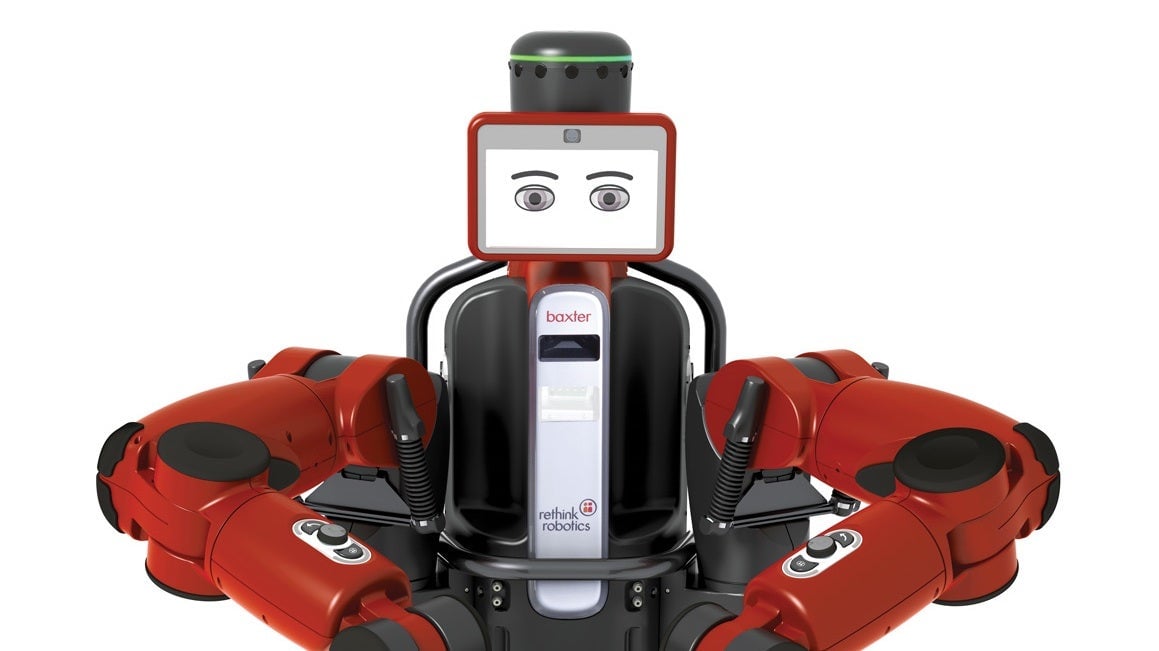

Baxter, the affordable, humanoid industrial robot recently unveiled by Rethink Robotics, is so easy to program that I once did it one-handed and drunk. We were at a party at the Massachusetts Institute of Technology (MIT), and he was standing in the corner, looking lonely. No, really—Baxter has expressive eyes projected on a touchscreen where you’d expect it to have a face, virtually guaranteeing that you’ll anthropomorphize it.
Drink in hand, I walked over and, with only the vaguest sense of how to get it to respond to my touch, grabbed it by the wrist. I guided its “hand” over to a box full of small objects. Its caliper-like fingers closed on a widget. Then I moved its hand, which offered almost no resistance at all, to another position on the table. It dropped the object.
After that, it dutifully repeated the procedure I had taught it, again and again, emptying the box. In a display of the sort of capabilities that used to be almost impossible in robotics but are now routine, its machine vision allowed it to cope with the differences in position and shape of each of the widgets. Baxter was untroubled by the poor lighting, loud music or my clumsiness. In less time than it takes to update my calendar, I had, in essence, trained Baxter to pack a box for shipping, or to transfer goods from one conveyor belt to another—two tasks that are common in manufacturing and distribution centers.
Manufacturing’s end-game
Since the end of the second world war, the proportion of people in the US who are working in manufacturing has declined steadily, from nearly 40% during the war to less than 10% today:
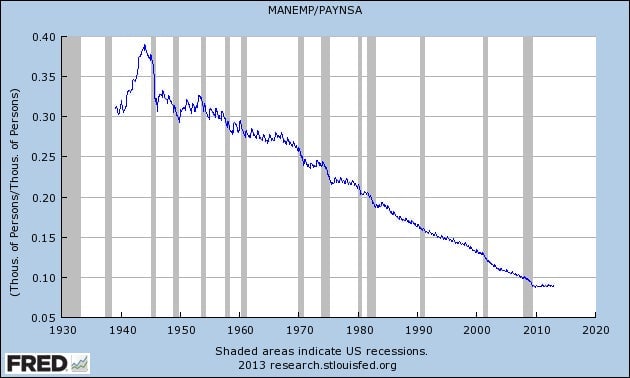
Many have blamed this decline on outsourcing—the movement of factories to countries where labor is cheaper. And there’s no doubt that outsourcing has led to fewer factory jobs in the US and other rich countries.
And yet the US, like almost every other rich country on the planet, manufactures more stuff than it ever did. Manufacturers have replaced workers with machines—trading labor for capital. This means the manufacturing workers who remain are many times more productive than their forebears 50 years ago.
Baxter and robots like it represent an inflection point in the long trend of top-of-the-line manufacturing: The point at which the old system, in which unskilled laborers still have a place in factories, is retired forever. In addition to Baxter, new robots from ABB, Universal Robots, Nextage and Redwood Robotics are finally smart enough to tend other robots.
The end of apprenticeships
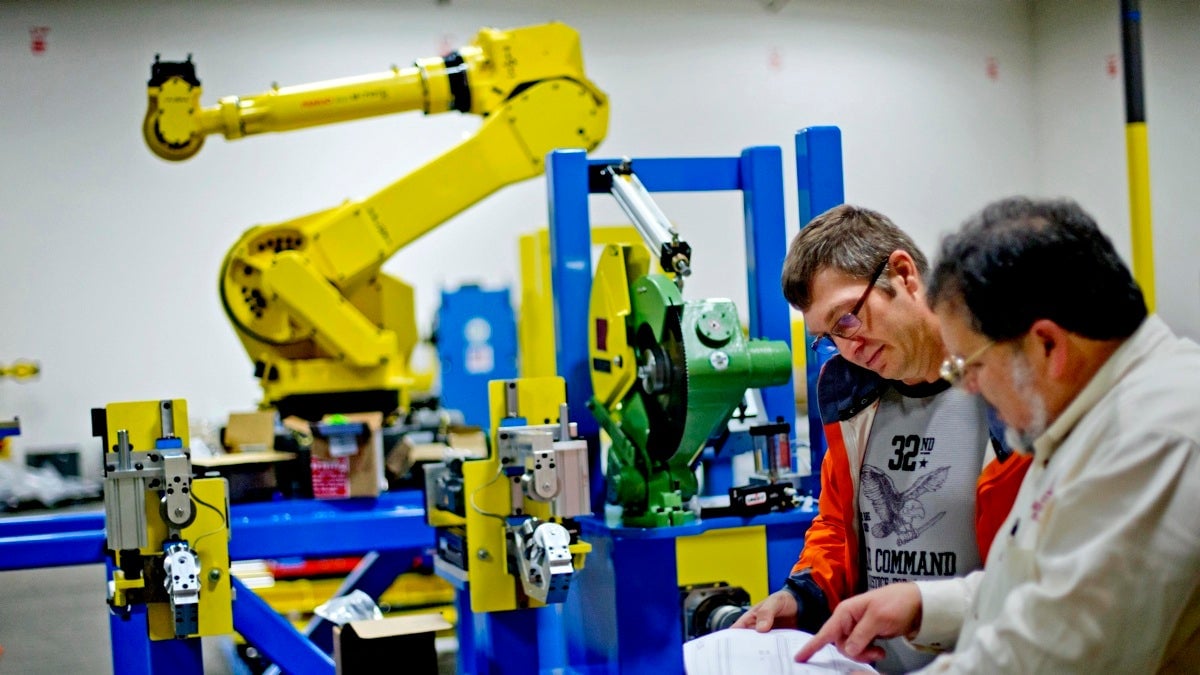
To understand how this plays out in the real world, it’s worth reading economics journalist Adam Davidson’s account of the lives of two factory workers at a highly automated car parts factory in Greenville, South Carolina. One, “Maddie,” is an unskilled laborer, or a “Level 1,” whose job it is to place parts into a machine that performs a particular operation on them without any adjustment from a human. The other, Luke Hutchins, got a two-year degree at vocational school, and can operate machines that require a great deal of experience and mathematical acumen, including calculus.
Luke earns 50% more than Maddie, but here’s the really important detail: Maddie’s job, like that of all Level 1’s, is “machine tending.” She merely enables a machine to work. In a few months, says Rodney Brooks, founder of Rethink Robotics, his Baxter robot will get an updated version of its software that will allow it to do machine tending.
Baxter might not replace Maddie immediately, but it suggests that sooner rather than later, the only people working in factories in rich countries any longer will be those who had the time and money to get college degrees. Consider: a large slice of America’s middle class used to consist of people who had started out working in factories despite having only a high school degree. The machines they worked with were comprehensible enough that people could learn on the job, slowly advancing, perhaps all the way up the ladder into management. That path to a middle-class wage is almost gone—and may finally be eliminated altogether.
Hollowing out the global middle class
What has happened in manufacturing is part of a larger paradox at the heart of America’s economy, says Erik Brynjolfsson, director of MIT’s Center for Digital Business. “More wealth was created in the past 10 years than ever before in history,” he says, “Yet at the same time millions of people are being left behind. The median worker in the US is poorer now than in the mid-1990s.”
Not everyone is suffering. Skilled workers, for example, are earning more than ever. So are the very rich, those who own the capital that can be put to work in the world’s increasingly person-free farms, mines and factories. But those who used to make middle-class wages are increasingly slipping into lower-paying, service-sector jobs. That’s led to what MIT economist David Autor calls an “hourglass economy,” with more workers at both the top and (mostly) the bottom of the income spectrum.
Here’s a chart from a 2010 paper by Autor (pdf) showing how that’s played out for various professions in the US.
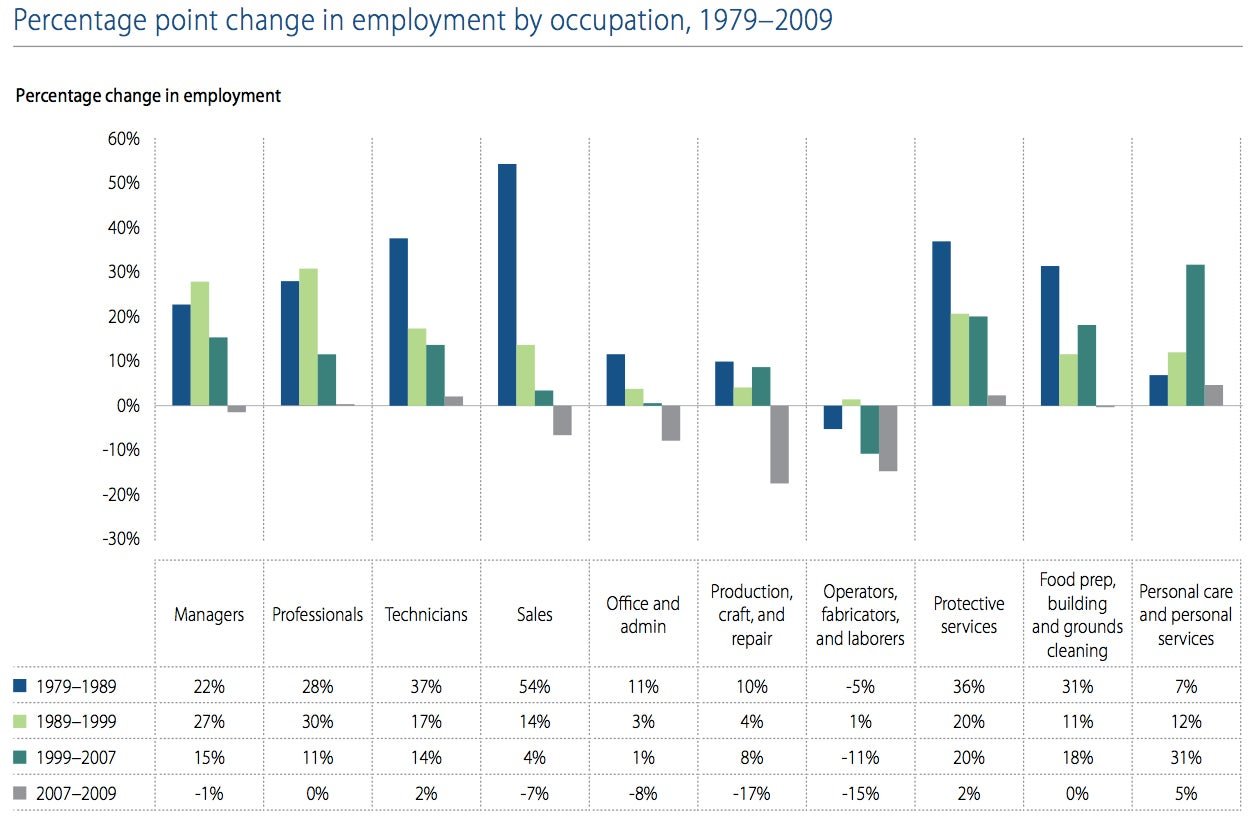
Notice that the three left-most occupation categories, the skilled trades including managers, professionals and technicians, have either held on to or slightly increased their ranks, even during the 2007-2009 recession. The middle four categories—sales, office and administrative, production and repair, and operators, fabricators and laborers, all saw their numbers decimated during the recession. (In the case of manufacturing workers, this was a continuation of previous trends.) Finally, the service industries on the right, including protective services, food preparation and cleaning, and personal care and services all performed about as well as the highest-paid classes of labor in terms of jobs gained (though not, obviously, in terms of wages).
While Autor’s work is necessarily backward-looking, the trends he describes seem to have only accelerated in the past 10 years, especially in manufacturing. If you look at the absolute number of manufacturing jobs in the US, for example, they go off a cliff after 2000, suggesting that the waist of the “hourglass economy” is only going to get narrower.
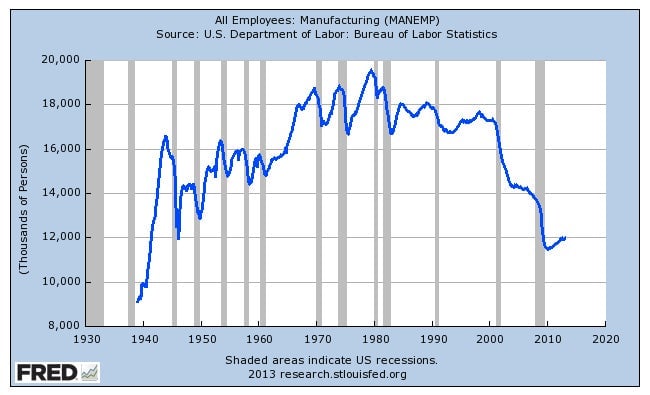
Here’s how Autor sums it up:
In 1979, the four middle-skill occupations—sales, office and administrative workers, production workers, and operators—accounted for 57.3 percent of employment. In 2007, this number was 48.6 percent, and in 2009, it was 45.7 percent. This sizable shift in job composition reflects three decades of employment growth at the tails of the occupational distribution.
Autor’s work shows that what’s happened to manufacturing is also happening to what economist Andrew McAfee calls routine cognitive workers, everyone from office secretaries who have been displaced by productivity software to librarians who lost their jobs to Google Search. Their plight is important to the larger story of the hourglass economy, but we’ll leave it for a future piece in Quartz’s ongoing obsession with the rise of the machines.
Coming soon, to a developing country near you

But wait, you say—what does this have to do with robots? What about China, the place where all those jobs are supposedly going? True, China has added manufacturing jobs over the past 15 years. But now it is getting on to the same path that the US and other rich countries are already much further down. Foxconn, which manufactures the iPhone and many other consumer electronics and is China’s largest private employer, has plans to install over a million manufacturing robots within three years. “Outsourcing is important,” says Brynjolfsson. “However my view is that technological change is much more important, especially in the long run. There’s a phrase I use to describe it: ‘offshoring is just a way-station on the road to automation.'”
Already, China is losing jobs to countries with even lower wages. But eventually, “you run out of places to chase the [cheap] labor,” says Rodney Brooks, chief technology officer of Rethink Robotics, which makes Baxter. While he believes that this means that eventually, rich countries will be forced to “re-shore” manufacturing capacity that they have sent overseas, it applies equally to developing countries: At some point, an aging population and ever-cheaper robots means that China’s factories will look a lot more like those in Japan, Germany and the US.
Training your non-human replacement
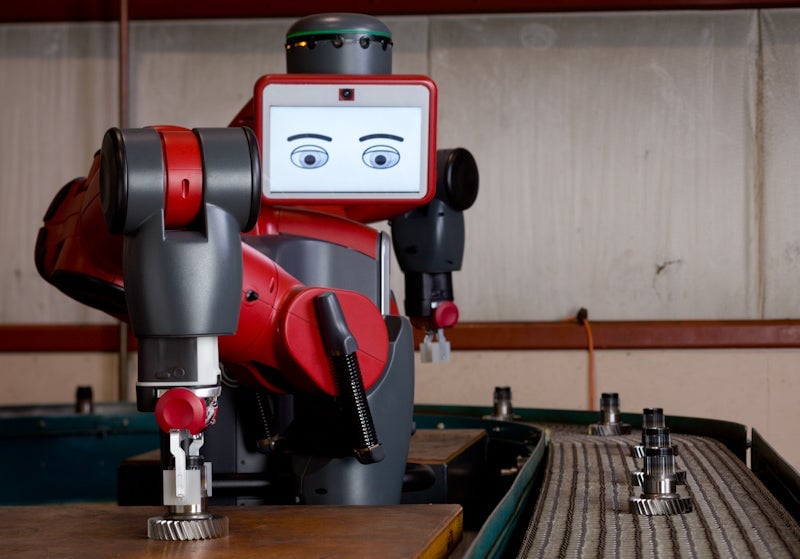
“There may not be a place for humans in the future, if we’re really successful,” Brooks told filmmaker Errol Morris back when he was just a roboticist at MIT. Since then, Brooks has given up his tenured academic job, founded and then stepped away from iRobot, maker of the Roomba automatic vacuum cleaner, and now is at Rethink Robotics.
Most industrial robots are large, expensive (costing $100,000 or more), and so hazardous to humans that they must be kept separate from people by plexiglass cages. They are also expensive to maintain and difficult to direct. Over its lifetime, the care and programming of an industrial robot can easily cost its owner two or three times its initial price tag.
But Baxter, as I discovered at that party at MIT, is ridiculously easy to program. Like information technology before it, robots won’t become ubiquitous until they’re easy to use, says Brooks, and that’s what’s so innovative about the products of Rethink Robotics. “In general, if you look at the factory floor, ease of use of equipment has not been a focus of attention,” says Brooks. “But it has been in the IT industry, and we’d not be where we are if laptops weren’t easy to use. An ordinary factory worker can train Baxter to do a task in just minutes.”
In factories, managers typically will not invest in any automation that requires more than two years to pay for itself, when compared to some other solution, like paying a human to do it. But thanks to some very clever engineering, Baxter only costs $22,000. In the US, a person working full time at minimum wage makes only $15,080 a year.
Brooks argues that, in its current incarnation, Baxter isn’t capable enough to replace a human worker. “The robot is not a one-to-one replacement,” says Brooks. “We see it as a tool for ordinary workers to do better.” The goal of Rethink, says Brooks, is to bring manufacturing back to the US by replacing with automation some of the repetitive tasks that are currently shipped to China and other emerging markets.
However, notes Brynjolfsson, while Baxter might bring manufacturing back to the US, “it’s not clear it will bring a lot of manufacturing jobs back to the US.” Economists at the Minneapolis Fed agree with him. Even if robots could help bring jobs back to rich countries like the US, manufacturing is already so automated that the number of jobs that could be gained in that process would be “modest.”
This time it’s different?
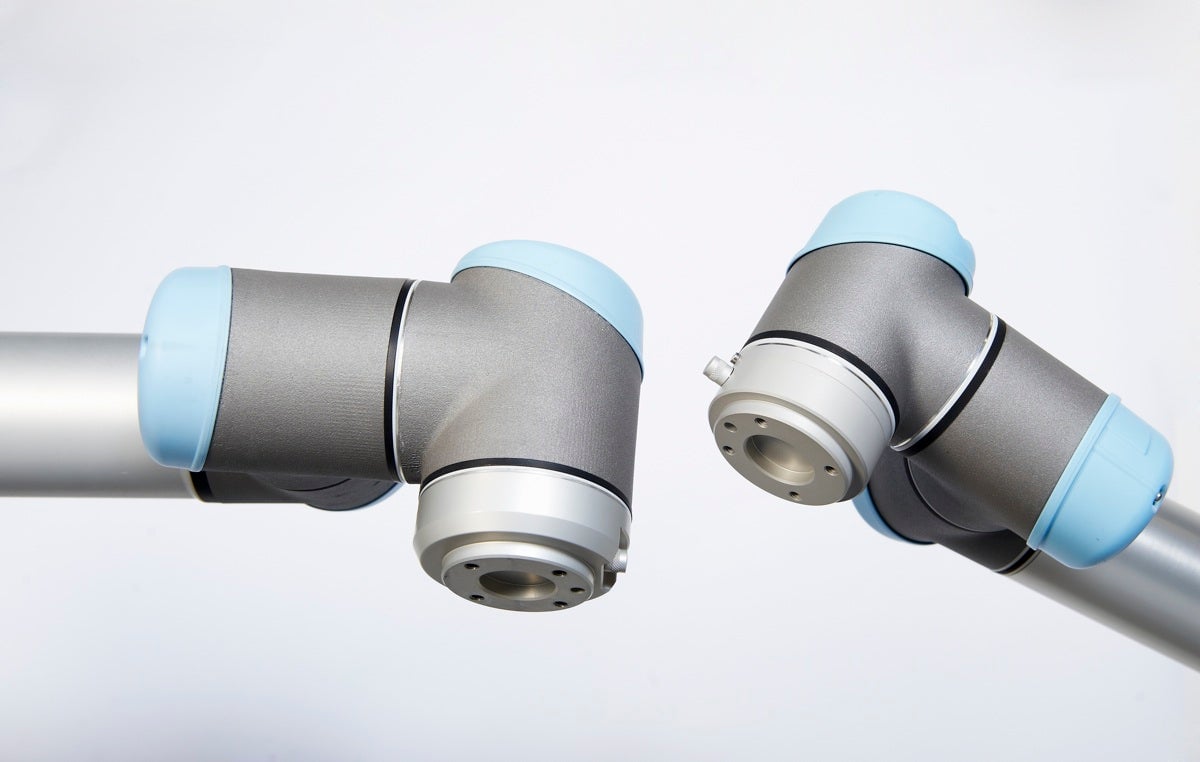
Whatever solutions we throw at the displacement of workers by machines, the coming decades could be difficult. “Economies don’t make these transitions well,” said Nobel prize-winning economist Joseph Stiglitz. Workers who can’t afford to forgo wages while they study or retrain can get stuck in unskilled, low-wage jobs, or simply end up jobless.
“As an economist, it’s not a bad thing when we get more stuff for less work,” says Brynjolfsson. “That’s what the system is designed to do. The issue is, can we reinvent and redesign our economic institutions to keep pace with this change so not all of the benefits accrue to a very small slice of people?”
Perhaps, as optimists like Kevin Kelly of Wired magazine suggest, the world is on the cusp of a revolution in localized, 3D-printed, custom manufacturing in which those who prosper will be those who are best at figuring out what to do with robots. But there is ample evidence that, in the meantime, the trend of ever more productive economies providing fewer middle-class jobs could continue.